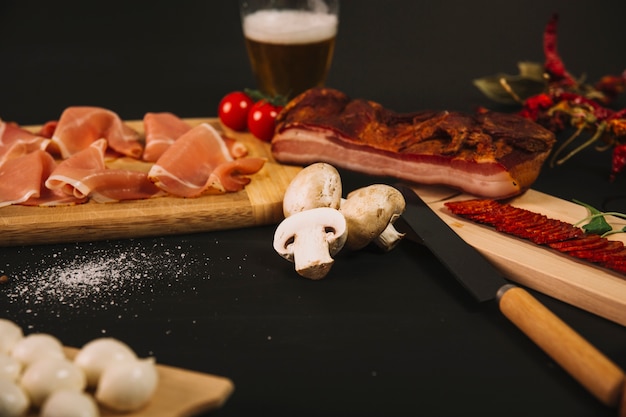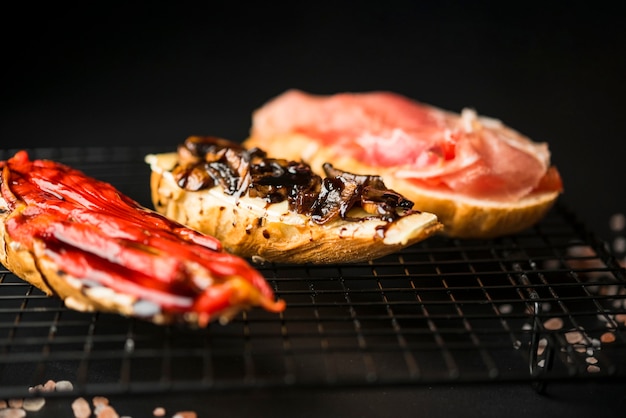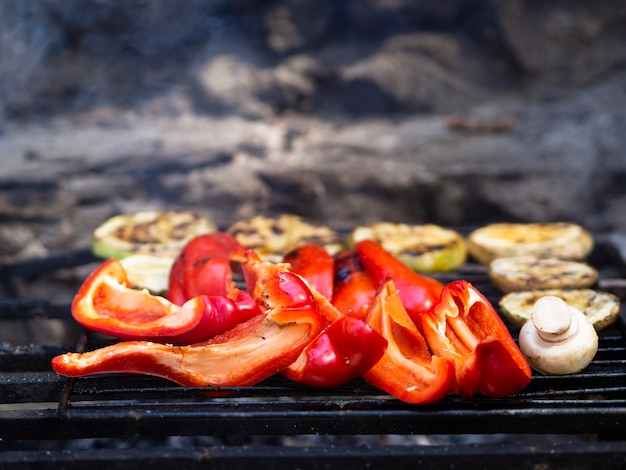(Part 1) Unlocking the Secrets of Crispness: A Scientific Dive into Bacon

But here's the catch: the rate of fat rendering is directly influenced by the temperature. Too low a temperature, and your bacon will end up limp and soggy, a culinary tragedy for any bacon lover. Too high, and you risk burning it before it has a chance to achieve that beautiful golden brown hue. Finding the perfect temperature is crucial to achieving the perfect balance of crispness and flavor.
High Heat: The Key to Crispy Bacon
The solution? High heat! Baking your bacon at a high temperature, around 400°F (200°C), speeds up the rendering process, resulting in faster crisping. Think of it like turning up the volume on the bacon's transformation, leading to a symphony of crispy goodness.
Of course, there's always a risk of burning. That's where the art of oven-baked bacon comes in. It's a delicate dance between heat, time, and careful observation. You'll need to keep a close eye on your bacon, making sure it doesn't burn, and be ready to adjust the cooking time based on your oven's quirks. But trust me, the effort is worth it. The reward? A bacon so crispy, it'll make your taste buds sing.
(Part 2) Choosing Your Weapon: The Many Faces of Bacon

Now that we've cracked the science, it's time to talk about the bacon itself. There's more to it than simply grabbing the first pack you see in the supermarket. The world of bacon is rich and diverse, offering a range of types and styles, each with its own unique flavor and texture.
We've got your classic streaky bacon, the thin and crispy option. Then there's the thick-cut bacon, known for its satisfying chew and robust flavor. smoked bacon adds a layer of smokiness, while maple-cured bacon boasts a sweet and savory profile. The choices are endless, each offering a distinct culinary experience.
Picking the Right Bacon for Oven-Baking
For oven-baking, my personal preference leans towards thicker-cut bacon. It tends to hold its shape better, preventing curling and resulting in a more satisfyingly chewy texture. However, if you're aiming for a faster cooking time, thinner bacon can work well.
Ultimately, the choice is yours. Experiment, explore different types, and discover your own personal bacon preference. It's a culinary journey worth taking!
Bacon Thickness: A Comparative Guide
Here's a table comparing some popular bacon types, highlighting their thickness, cooking time, and resulting texture:
| Bacon Type | Thickness | Cooking Time | Texture |
|---|---|---|---|
| Streaky Bacon | Thin | Faster | Crispy and brittle |
| Thick-Cut Bacon | Thick | Longer | Chewy and substantial |
| Smoked Bacon | Variable | Depends on thickness | Smoky flavour, chewy texture |
(Part 3) Setting the Stage: The Art of bacon preparation

You've chosen your bacon, now it's time to set the stage for its culinary transformation. This step might seem simple, but it's essential for achieving that perfect crisp. Think of it as a chef meticulously preparing their ingredients before starting the cooking process, setting the foundation for success.
The Baking Sheet with a Rack: A Culinary Game-Changer
First, invest in a baking sheet with a wire rack. This is a culinary game-changer for oven-baked bacon. It allows air to circulate freely around the bacon, ensuring even rendering and preventing the dreaded soggy bacon stuck to the bottom of the pan.
Spreading it Out: Giving Each Bacon Strip Its Space
Next, spread out your bacon strips on the rack, ensuring they're not overlapping. This prevents steaming, which can lead to uneven cooking and a less-than-crispy outcome. It's like giving each bacon strip its own space to shine, to reach its full crispy potential.
Protecting Your Oven: The Power of Foil
Lastly, if you're concerned about bacon grease splattering all over your oven, line the baking sheet with foil. This will help catch the drips and make cleaning up a breeze. Just remember to fold the edges up a bit to create a barrier, preventing your bacon from swimming in a pool of grease.
(Part 4) Mastering the Heat: Finding the Right Oven Temperature
Your bacon is prepped and ready to go, but the real challenge lies in finding the perfect oven temperature. It's a delicate dance between heat and time, a balance that can make or break your bacon experience.
The Golden Rule: High Heat for Crispy Bacon
The general rule of thumb is to bake bacon at a high temperature, around 400°F (200°C). This encourages fast fat rendering, leading to that beautifully crisp texture we all crave.
Oven Variability: Adjusting for Your Specific Oven
However, remember that ovens can vary in their temperature accuracy. Some might run hot, while others might run cold. It's important to check your oven's performance and adjust accordingly. Keep an eye on your bacon and be prepared to modify the cooking time based on your oven's quirks.
Timing is Everything: Finding the Right Balance
Speaking of timing, cooking time will also vary depending on the thickness of your bacon. Thicker bacon requires more time to cook through compared to thinner slices.
Doneness: Recognizing the Signs of Crispy Perfection
So, how do you know when your bacon is perfectly cooked? It's all about those beautiful golden edges. Look for a nice, even crispness around the edges, and you'll know it's time to take it out of the oven.
(Part 5) The Art of Patience: Watching Over Your Bacon
Oven-baked bacon is a bit like a slow-cooked meal; it requires time and patience to reach its peak of perfection. It's not a "set it and forget it" affair. You need to keep a watchful eye on your bacon, like a hawk guarding its prey, ready to make adjustments as needed.Avoiding Burnt Edges: The Importance of Rotation
Remember, ovens can have hot spots, so it's essential to rotate the baking sheet halfway through cooking time. This ensures even cooking and prevents any burnt edges.
Achieving Double-Sided Crispness: The Flip Technique
For an extra crispy bacon experience, flip the strips halfway through cooking time. This technique helps achieve a double-sided crispness, making your bacon even more irresistible. Just be careful when flipping them, as they can be quite fragile at this stage.
The Ultimate Test: Checking for Doneness
To check for doneness, take a strip out of the oven and gently press on it. If it feels firm and snaps easily, you're good to go. If it feels soft and pliable, it needs a few more minutes in the oven.
(Part 6) The Finishing Touches: Elevating Your Bacon with Flavor and Texture
Your bacon is cooked to crispy perfection, but why stop there? Let's take it to the next level with some delicious finishing touches, adding layers of flavor and texture that will truly elevate your bacon experience.
The Power of Seasoning: Adding Depth of Flavor
A simple sprinkle of seasoning before baking can transform your bacon from ordinary to extraordinary. A pinch of black pepper, a dash of paprika, or even a sprinkle of garlic powder adds a whole new dimension of flavor.
Sweet and Savory: The Allure of Maple Syrup
For a sweet and savory twist, try drizzling your bacon with a little bit of maple syrup before baking. This creates a caramelized glaze that's both sweet and salty, adding a delightful complexity to the flavor profile.
The Crispy Crunch: Adding Textural Contrast
For an extra bit of crunch, sprinkle a few crumbled potato chips or crushed nuts onto your bacon before baking. This adds a delightful textural contrast to the crispy bacon, creating a multi-sensory experience.
The Spice Factor: Infusing with Chili Flakes
If you enjoy a bit of heat, add a pinch of chili flakes to your bacon before baking. This adds a subtle kick of spice that's both exciting and satisfying, turning up the heat on your taste buds.
(Part 7) Post-Bake Perfection: Storing and Serving Your Crispy Masterpiece
Your bacon is cooked, seasoned, and ready to be enjoyed. But before you dive in, there are a few important steps to preserve its crispness and ensure optimal enjoyment.
Cool It Down: Letting the Fat Solidify
First, let your bacon cool down on a wire rack for a few minutes. This allows the fat to solidify, preventing it from becoming greasy and making it easier to handle.
Storing Leftovers: Keeping the Crisp Intact
If you have any leftover bacon, store it in an airtight container in the refrigerator. For optimal crispness, I recommend storing it on a wire rack rather than stacking it. This helps prevent it from becoming soggy.
Serving Suggestions: Crispy Bacon at its Best
When it comes to serving, the possibilities are endless. Enjoy your crispy bacon as a standalone snack, use it to top salads, sandwiches, pizzas, or even breakfast burritos.
Here are some of my favorite ways to enjoy oven-baked bacon:
- Bacon and Eggs: A classic combination for a reason. The crispy bacon adds a delightful crunch to your morning eggs, a perfect start to the day.
- Bacon-Wrapped Dates: A sweet and savory treat that's perfect for a party appetizer. Simply wrap a piece of bacon around a date and bake until the bacon is crispy and the dates are caramelized, creating a delightful balance of flavors and textures.
- Bacon-Cheddar Dip: This decadent dip is perfect for serving with crackers or vegetables. Simply blend cooked bacon, cheddar cheese, and cream cheese until smooth, creating a creamy and savory dip that's sure to be a crowd-pleaser.
(Part 8) FAQs: Addressing Your Burning Questions
You've heard my tips, tricks, and secrets to achieving oven-baked bacon perfection. But you still have some burning questions, don't you? Let's tackle those head-on, offering solutions to your bacon dilemmas.
- Can I cook bacon in the oven with other things, like chicken or vegetables?
It's not recommended to cook bacon in the oven with other foods. The bacon will release a lot of fat, which can make other foods greasy and soggy, compromising their texture and flavor.
To avoid this, cook your bacon separately on a baking sheet with a rack. Then, once it's cooked, you can add it to other dishes, allowing you to control the level of bacon fat and ensure optimal results for your entire meal.
- What if my bacon is too salty?
If your bacon is too salty, there's not much you can do once it's cooked. However, you can try soaking it in water for a few minutes to reduce the saltiness, although this might compromise its texture.
In the future, try using a less salty bacon or soaking it in water before cooking. This can help you adjust the saltiness before it's fully cooked.
- How do I keep my bacon from curling up?
Sometimes, bacon can curl up in the oven, especially if it's too thin. To prevent this, try placing a piece of parchment paper over the bacon before baking. This helps hold it down and prevents it from curling up, ensuring a more uniform and aesthetically pleasing result.
- What are the best ways to store bacon?
The best way to store bacon is in an airtight container in the refrigerator. It should last for up to a week, preserving its freshness and flavor.
You can also freeze bacon for up to 3 months. To freeze bacon, wrap it tightly in plastic wrap or aluminum foil and place it in a freezer bag. This ensures proper storage and prevents freezer burn, preserving its quality.
- What is the best way to reheat bacon?
The best way to reheat bacon is in a skillet over medium heat. This method allows you to crisp it up again while avoiding a soggy texture. You can also reheat it in the oven at a low temperature.
To reheat bacon in the oven, place it on a baking sheet and bake at 200°F (90°C) for 5-10 minutes. This method is great for reheating multiple slices at once and ensures a gentle reheating process.
It's not recommended to cook bacon in the oven with other foods. The bacon will release a lot of fat, which can make other foods greasy and soggy, compromising their texture and flavor.
To avoid this, cook your bacon separately on a baking sheet with a rack. Then, once it's cooked, you can add it to other dishes, allowing you to control the level of bacon fat and ensure optimal results for your entire meal.
If your bacon is too salty, there's not much you can do once it's cooked. However, you can try soaking it in water for a few minutes to reduce the saltiness, although this might compromise its texture.
In the future, try using a less salty bacon or soaking it in water before cooking. This can help you adjust the saltiness before it's fully cooked.
Sometimes, bacon can curl up in the oven, especially if it's too thin. To prevent this, try placing a piece of parchment paper over the bacon before baking. This helps hold it down and prevents it from curling up, ensuring a more uniform and aesthetically pleasing result.
The best way to store bacon is in an airtight container in the refrigerator. It should last for up to a week, preserving its freshness and flavor.
You can also freeze bacon for up to 3 months. To freeze bacon, wrap it tightly in plastic wrap or aluminum foil and place it in a freezer bag. This ensures proper storage and prevents freezer burn, preserving its quality.
The best way to reheat bacon is in a skillet over medium heat. This method allows you to crisp it up again while avoiding a soggy texture. You can also reheat it in the oven at a low temperature.
To reheat bacon in the oven, place it on a baking sheet and bake at 200°F (90°C) for 5-10 minutes. This method is great for reheating multiple slices at once and ensures a gentle reheating process.
There you have it, my friends! A comprehensive guide to oven-baked bacon, from the science behind the crisp to the finishing touches that make it truly irresistible. Remember, it's all about finding your own perfect balance of heat, time, and technique. So get out there, experiment, and enjoy the crispy goodness of oven-baked bacon!
Everyone is watching

How to Cook Frozen Lobster Tails Perfectly: A Step-by-Step Guide
RecipesLobster. Just the word conjures up images of lavish meals, special occasions, and a taste of luxury. But let's...

Pigs in a Blanket Cooking Time: How Long to Bake for Perfect Results
RecipesAh, pigs in a blanket. Just the name conjures up images of those delightful little parcels of crispy pastry en...

Pork Fillet Cooking Time: How Long to Cook It Perfectly
RecipesPork fillet, or tenderloin as it's sometimes called, is a real favourite in our house. It's so versatile, and...

The Ultimate Guide to Cooking Sweet Potatoes: From Roasting to Mashing
RecipesSweet potatoes. Just the name conjures up images of warm, comforting dishes, bursts of vibrant color, and a to...

The Ultimate Guide to Tender, Juicy Pulled Pork
RecipesRight, let's talk pulled pork. It's one of those dishes that just screams "comfort food," doesn't it? I mean...
